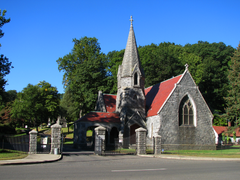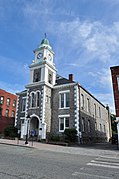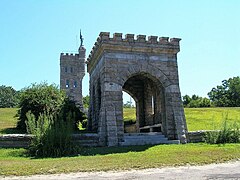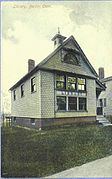Robert W. Hill
Robert Wakeman Hill | |
|---|---|
 Robert W. Hill, 1895 | |
| Born | September 20, 1828 |
| Died | July 16, 1909 Waterbury, Connecticut |
| Nationality | United States |
| Occupation | Architect |
| Buildings | Ansonia Opera House; Waterbury City Hall; Bronson B. Tuttle House; New Britain Opera House; Thomaston Town Hall; Litchfield County Courthouse; Soldiers' Memorial Tower |
Robert W. Hill (20 September, 1828 – 16 July, 1909) was an American architect from Waterbury, Connecticut. He was one of Connecticut's most important 19th century architects.
Life and career
Robert Wakeman Hill was born in Waterbury of September 20, 1828, to Samuel and Polly (Brackett) Hill. He attended the public schools, after which he went to New Haven to study architecture. He first attended the Young Men's Institute, where he learned architectural drawing. He obtained a position in the office of Henry Austin, during which he also taught at the YMI.[1] At one point he was also employed by Sidney Mason Stone.[2] He then worked in Milwaukee, Wisconsin for Albert C. Nash, a former Connecticut architect. In 1858 he returned to Connecticut, establishing himself as an architect in the town of Naugatuck. In 1863 he relocated to Waterbury, where he would quickly become the city's most prominent architect, a position he retained for the rest of his career.[1]
Legacy
Hill trained several other Waterbury architects, including Joseph A. Jackson, Wilfred E. Griggs, and Theodore B. Peck.[1] At least five buildings designed by him have been placed on the National Register of Historic Places, and many others contribute to listed historic districts.
Works
- 1865 - St. Margaret's School, 88 Cooke St, Waterbury, Connecticut[1]
- Demolished.
- 1866 - John Kendrick House, 119 W Main St, Waterbury, Connecticut[3]
- Often attributed to Hill or his teacher, Henry Austin.
- 1866 - Warren House, 110 Woodbury Rd, Watertown, Connecticut[1]
- Later the Taft School's main building. Demolished.
- 1869 - Christ Episcopal Church (remodeling), Main St S, Bethlehem, Connecticut[4]
- 1869 - Opera House Block, 100 Main St, Ansonia, Connecticut[1]
- 1869 - Waterbury City Hall (former), 55 W Main St, Waterbury, Connecticut[5]
- Burned in 1912.
- 1870 - Post Office Block, 1 W Main St, New Britain, Connecticut[1]
- 1871 - Edward M. Chapin House, 25 Church St, New Hartford, Connecticut[6]
- 1871 - Soldiers' Monument, Woodbury Common, Woodbury, Connecticut[7]
- 1874 - First Congregational Church Centennial Chapel, 251 Main St, East Haven, Connecticut[8]
- 1878 - Albert C. Peck House, 8 Mountain Rd, Woodbury, Connecticut[9]
- 1879 - Bronson B. Tuttle House, 380 Church St, Naugatuck, Connecticut[10]
- 1879 - William H. Anderson House, Andover Street, [Lowell, Massachusetts][11] ** Demolished.
- 1880 - New Britain Opera House, 466-468 Main St, New Britain, Connecticut[12]
- Demolished.
- 1880 - Winsted Real Estate Building, 13-17 Park Pl W, Winsted, Connecticut[13]
- 1881 - Coe Brass Office Building, 179 Water St, Torrington, Connecticut[14]
- 1882 - Welton Street School (former), 36 Welton St, Waterbury, Connecticut[15]
- 1882 - Thomaston Fire Station, Main St, Thomaston, Connecticut
- 1883 - Hall Memorial Chapel, Riverside Cemetery, Waterbury, Connecticut[16]
- 1883 - Thomaston Town Hall and Opera House, 153 Main St, Thomaston, Connecticut[17]
- 1883 - Waterbury Armory, Phoenix Ave, Waterbury, Connecticut[1]
- Demolished.
- 1883 - Watertown Library (former), 50 DeForest St, Watertown, Connecticut[18]
- Now owned by the Taft School.
- 1884 - Griggs Building, 221-227 Bank St, Waterbury, Connecticut[19]
- 1885 - Bridgeport Armory, 1494 Main St, Bridgeport, Connecticut[20]
- Highly altered.
- 1885 - Rectory for St. John's Episcopal Church, 21 Church St, Waterbury, Connecticut[21]
- 1886 - Ansonia Station, 40 W Main St, Ansonia, Connecticut[22]
- Demolished.
- 1886 - New Britain Armory (former), 10 Grand St, New Britain, Connecticut[23]
- 1886 - Norwalk Armory, Connecticut Ave, Norwalk, Connecticut[24]
- Demolished.
- 1887 - Congregational Parish House, Division St, Naugatuck, Connecticut[25]
- 1888 - Litchfield County Courthouse, 15 West St, Litchfield, Connecticut[26]
- Altered.
- 1889 - Police Department Headquarters, Leavenworth St, Waterbury, Connecticut[27]
- Demolished.
- 1890 - Soldiers' Memorial Tower, Memorial Park, Winsted, Connecticut[28]
- With George Edwin Bissell, sculptor.
- 1891 - Berlin Free Library (former), Worthington Ridge, Berlin, Connecticut[29]
- Demolished in 1955.
- 1891 - Conway (Yankee Pedlar) Inn, 95 Main St, Torrington, Connecticut[30]
- 1891 - Litchfield Fire Station (former), 40 West St, Litchfield, Connecticut[4]
Gallery
-
John Kendrick House, Waterbury, 1866.
-
Waterbury City Hall, Waterbury, 1869.
-
Fire Station, Thomaston, 1882.
-
Hall Memorial Chapel, Riverside Cemetery, 1883.
-
Griggs Building, Waterbury, 1884.
-
County Courthouse, Litchfield, 1888.
-
Soldiers' Memorial, Winsted, 1890.
-
Berlin Free Library, Berlin, 1891.
-
Conley Inn, Torrington, 1891.
-
Fire Station, Litchfield, 1891.
References
- ^ a b c d e f g h The Town and City of Waterbury, Connecticut. Ed. Joseph Anderson. 1896.
- ^ "Robert Wakeman Hill". Bronson Library.
- ^ John Kendrick House NRHP Nomination. 1982.
- ^ a b Bethlehem Green Historic District NRHP Nomination. 1982.
- ^ Wiehn, John and Mark Heiss. Postcard History Series: Waterbury 1890-1930. Charleston, SC: Arcadia, 2003.
- ^ Sterner, Daniel. "Chapin Park (1871)". http://historicbuildingsct.com/. 30 March 2010.
- ^ Cothren, William. History of Ancient Woodbury, Connecticut. Vol. 2. 1872.
- ^ Hughes, Sarah E. History of East Haven. New Haven: Tuttle, Morehouse & Taylor, 1908.
- ^ Woodbury (CT) Reporter 19 Sept. 1878.
- ^ Bronson B. Tuttle House NRHP Nomination. 1990.
- ^ Lowell Daily Citizen 12 August 1879.
- ^ New Britain Opera House NRHP Nomination. 1977
- ^ American Architect and Building News 10 April 1880: 160.
- ^ Water Street Historic District NRHP Nomination. 2003.
- ^ American Architect and Building News 28 Oct. 1882: 212.
- ^ Sanitary Engineer 21 June 1883: 67. Chicago.
- ^ Thomaston Opera House NRHP Nomination. 1972.
- ^ Sterner, Daniel. "Walker Hall (Former Watertown Library) (1883)". http://historicbuildingsct.com/. 16 July 2013.
- ^ Bank Street Historic District NRHP Nomination. 1983.
- ^ American Architect and Building News 7 Nov. 1885 : 228. Boston.
- ^ American Architect and Building News 14 Nov. 1885 : 240. Boston.
- ^ American Engineer 10 June 1886: 235-236. New York.
- ^ Sterner, Daniel. "New Britain Armory (1886)". http://historicbuildingsct.com/. 1 Nov. 2013.
- ^ American Architect and Building News 1886: 206. Boston.
- ^ Naugatuck Center Historic District NRHP Nomination. 1999.
- ^ Building 6 Oct. 1888: 3. New York.
- ^ Municipal Register of the City of Waterbury for the Year 1889. Waterbury: Malone & Cooley, 1890.
- ^ "Soldiers' Memorial Tower". Frank Leslie's Illustrated Newspaper: 155. 4 April 1891. New York.
- ^ Library Journal Sept. 1891: 282.
- ^ Sterner, Daniel. "The Yankee Pedlar Inn (1891)". http://historicbuildingsct.com/. 15 Feb. 2012.











